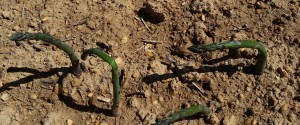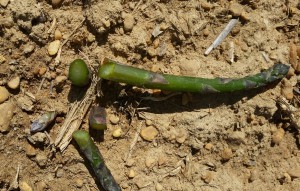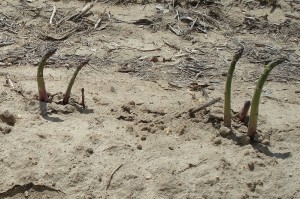Collar rot (Alternaria linariae) or Alternaria stem rot (Alternaria alternata f. sp. lycopersici) of tomato are common in young tomato plants. Either can be particularly troublesome in seedlings that have been held in transplant flats for an extended period of time before transplanting in hot, humid greenhouses. Collar rot infections often start where a leaflet branch has been broken or pruned which allows a point of infection. Symptoms of Alternaria stem rot include brown circular to irregular lesions on stems with definitive concentric black rings (very similar to Early blight on infected leaves). Symptoms of Collar rot are similar and may or may not produce concentric black rings. Infections that start in the greenhouse may lead to losses in the field as stems become girdled causing the plant or branches to wilt and die. Most commercial tomato varieties have resistance to Alternaria stem rot. While resistance is lacking to Collar rot, growers should chose varieties with Early blight resistance. Fungicides used to control Early blight are also effective against Collar rot.
Symptoms of Collar rot in young tomato |



 next production season. With the season we had last year and the wet spring we’ve had thus far this year season, pressure due to purple spot may be high. Control of purple spot can be difficult because of management issues (i.e., the mowing and chopping up and leaving of old fern material in the field) and because fungicides can’t be applied during the harvest season. Growers who had pre-mature defoliation issues last year may expect problems this spring. Remember, controlling purple spot begins with preventative fungicide applications during summer and fall by reducing infections to ferns and stalks. Weekly scouting should be done in the spring and followed up with additional scouting and timely fungicide applications once fern stalks are full size. Apply and rotate azoxystrobin (FRAC group 11) at 6.2 to 15.5 fl oz 2.08F/A with chlorothalonil at 2.0 to 4.0 pt/A.
next production season. With the season we had last year and the wet spring we’ve had thus far this year season, pressure due to purple spot may be high. Control of purple spot can be difficult because of management issues (i.e., the mowing and chopping up and leaving of old fern material in the field) and because fungicides can’t be applied during the harvest season. Growers who had pre-mature defoliation issues last year may expect problems this spring. Remember, controlling purple spot begins with preventative fungicide applications during summer and fall by reducing infections to ferns and stalks. Weekly scouting should be done in the spring and followed up with additional scouting and timely fungicide applications once fern stalks are full size. Apply and rotate azoxystrobin (FRAC group 11) at 6.2 to 15.5 fl oz 2.08F/A with chlorothalonil at 2.0 to 4.0 pt/A.